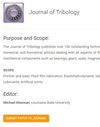On the uniqueness of wear coefficient for abrasive wear at nanoscale
IF 3
3区 工程技术
Q2 ENGINEERING, MECHANICAL
引用次数: 1
Abstract
Materials wear is often characterized by empirical relations as the physical and chemical interactions at sliding interfaces are not fully understood at any length scale. Recent studies showed that these wear relations do not always hold in particular at the nanoscale. Here we discuss the validity range and limitations of two well-known wear models, i.e. Archard's and Reye's ones (which were principally developed for adhesive wear) for abrasive wear process. Using systematic long-timescale molecular dynamic nanoscratching simulations, we show that, at the nanoscale, the wear coefficient increases by the adhesion strength and scratching depth and eventually saturates to a constant value. The saturation is associated with the transition from atomic attrition wear mode to plasticity-induced wear. This new understanding rationalizes discrepant experimental observations on the validity of Archard's wear relation at the nanoscale. Furthermore, it confirms that a depth- and adhesion-independent wear coefficient can be obtained when plastic deformation dictates the abrasive wear process.纳米级磨料磨损磨损系数的唯一性
材料磨损通常以经验关系为特征,因为在任何长度尺度上都不能完全理解滑动界面处的物理和化学相互作用。最近的研究表明,这些磨损关系在纳米尺度上并不总是特别成立。在这里,我们讨论了两个著名的磨损模型的有效范围和局限性,即Archard和Reye的磨损模型(主要是为粘性磨损开发的)。使用系统的长时间尺度分子动力学纳米划痕模拟,我们表明,在纳米尺度上,磨损系数随着粘合强度和划痕深度的增加而增加,并最终饱和到恒定值。饱和与原子磨损模式向塑性磨损模式的转变有关。这一新的理解使对Archard磨损关系在纳米尺度上的有效性的不同实验观察结果合理化。此外,它证实了当塑性变形决定磨料磨损过程时,可以获得与深度和附着力无关的磨损系数。
本文章由计算机程序翻译,如有差异,请以英文原文为准。
求助全文
约1分钟内获得全文
求助全文
来源期刊
CiteScore
4.20
自引率
12.00%
发文量
117
审稿时长
4.1 months
期刊介绍:
The Journal of Tribology publishes over 100 outstanding technical articles of permanent interest to the tribology community annually and attracts articles by tribologists from around the world. The journal features a mix of experimental, numerical, and theoretical articles dealing with all aspects of the field. In addition to being of interest to engineers and other scientists doing research in the field, the Journal is also of great importance to engineers who design or use mechanical components such as bearings, gears, seals, magnetic recording heads and disks, or prosthetic joints, or who are involved with manufacturing processes.
Scope: Friction and wear; Fluid film lubrication; Elastohydrodynamic lubrication; Surface properties and characterization; Contact mechanics; Magnetic recordings; Tribological systems; Seals; Bearing design and technology; Gears; Metalworking; Lubricants; Artificial joints

 求助内容:
求助内容: 应助结果提醒方式:
应助结果提醒方式:


